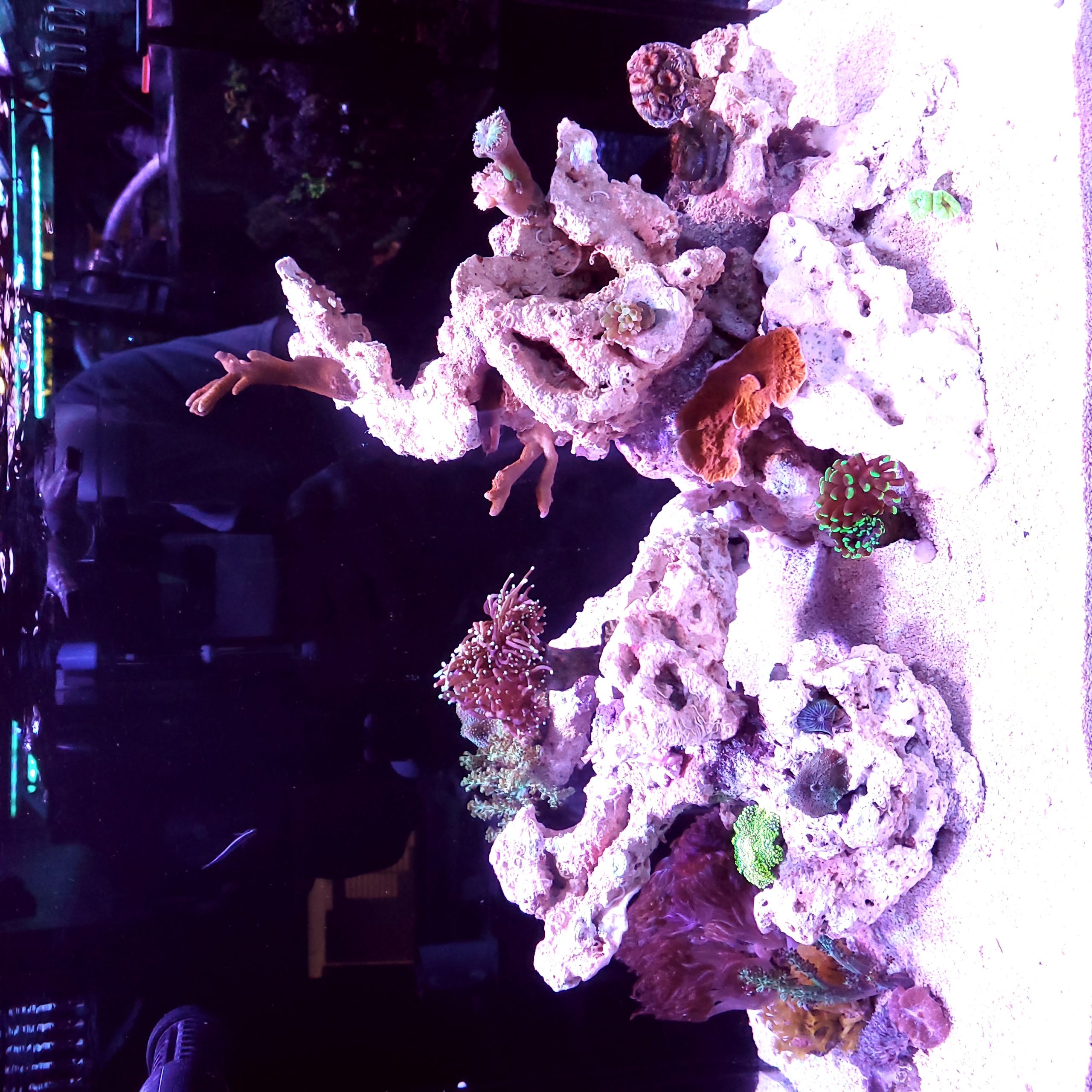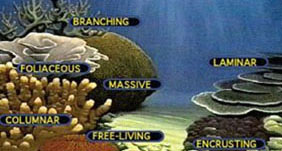
Preface: This Reef Mentoring article series is to document my recommendations to a hobbyist I have been mentoring. I am basically building a reef tank with his setup at my house and maintaining it for a year with weekly in person hands on sessions.
After a few weeks of cycling per my previous article it was time to add some livestock to the system. In recent years a slight change was made to the order of which organisms to add first. Originally, tanks introduced a single hardy fish to cycle the system, but with more efficient “fishless cycling” methods and a better understanding of organism requirements, we can now introduce hardy corals first. The reason is that the bioload of corals is much less than fish: fish release ammonia through their gills so it impacts the nitrogen cycling more. The addition of some hardy corals can also aid in bringing established beneficial bacteria into the system.
Live Stock Requirements
The Reef Mentoring Project nano reef tank is just a small Water Box 30.2 AIO system. On Day 14 all the the mentee’s original livestock and some of mine were added. But before you buy and add them into the tank the specific requirements for lighting, flow, and nutrient uptake and growth behavior should be understood to determine the correct placement of corals. Habitat constraints and nutrition requirements should be researched for the fish prior to purchase. So please do your homework and plan it out beforehand, so you know what will sustainably thrive in the size tank provided. As I always say, “It’s always cheaper on paper.”
Current Livestock List:
Note: All the livestock came from the mentee’s original tank, pre-quarantined and living in my 510 gallon system for a couple of months prior to this point in time.
- Soft Corals: Anthelia, Red Sea Pulsing Xenia, Yellow Parazoanthus polyps, Discosoma Mushrooms (Turquoise, Speckled), Green Ricordia Mushroom, Cabbage Leather, Toadstool Leather, Green Nepthea
- LPS: Torch, Hammer, Frogspawn, Micromussa lordhowensis, Candy Cane Coral
- SPS: Peach and Forest Fire Montipora digitata, Milka Stylophora and Red Montipora Capricornis
- Invertebrates: 1 Blue Leg hermit crab, 3x Stomatella Snails, 2x Cerith Snails
- Fish: Tail Spot Blenny, Blue Neon Goby, 2 Oscellaris Clownfish, Royal Gramma, 6 Line Wrasse
Coral Placement Factors
Lighting
When creating the aquascape for this tank the Rule of 3rds was used. We can similarly divide the tank height into 3rds to create the zones for lighting and flow. Obviously the top zone will have the highest flow and lighting. The lighting for each mounting position can be quantified with a Quantum (P.A.R.) meter if available. Currently the system is only running at 60% intensity during the acclimation time frame. As a reference, Tidal Gardens generally categorize lighting zones low (30-50 moles per m2 per second), medium (50-150 moles per m2 per second) , and high (150 + moles per m2 per second) lighting.
Flow
The flow can be evaluated based on how the aquascape is created, the circulation pump placement, and the potential growth shape of the coral. Hence it is important to consider those factors in the design of the tank up front. Recent discussions have placed flow as a higher priority over lighting since flow brings nutrients and removes waste from sedentary corals. Everything looks great when the flow pumps are working but when the pumps are clogged with algae and flow is reduced (as the only change) the coral may appear to suffer.
Growth Shape and Behavior
One of the least understood factors by beginners are the coral’s mature growth shape and behavior. Most corals are purchased as small frags and it is hard to know their full growth potential. Research or talk to someone knowledgeable prior to purchase.
Tips:
- Place most encrusting or plating corals on the lower stratum to avoid shadowing everything below it
- Categorize stony corals by growth shapes as seen below

Hard coral growth types. (http://krupp.wcc.hawaii.edu)
- Fast growing soft corals that spread by encrusting should be on an island of their own and surrounded by gravel to prevent it from taking over
- Aggressive corals such as torch corals or certain chalices like higher flow and boundary space for sweeper tentacles
- Group similar corals together so they can coexist and not have any downsides touching each other
- Be aware of corals that reproduce by budding such as Toadstool leathers, Xenia, etc. since they can spread to areas you do not want them to be and overtake the tank
- For anemones, placement is somewhat up in the air since they will move on their own to find a spot they will be happy with. Guard flow pumps and overflow grates to prevent anemones from getting sucked into or clog up the drain slots
Color Coordination
The color of the corals should be the final factor in the design and layout of the reef system. Lighting, flow, and growth behavior prioritize the health of the corals while color placement is a factor for the aquarist. The color wheel is a great tool to help create a balanced view when viewing the tank in each plane. This eliminates the haphazard mounting of corals that may have a jumbled appearance with no organization. Sure “beauty is in the eye of the beholder” but if you are looking for some type of strategy to build upon the “Rule of Thirds” applied to the aquascape then give this a try.
Below is a great video I stumbled across that explains how a color wheel is used.
Adding Clean Up Crew
One of the most important additions to your system is the “Clean Up Crew.” This may consist of any life form that eats various forms of algae, dead organics, detritus, bacterial films, diatoms, and also maintain the health of the sand bed. They perform 24 hour natural maintenance on the reef. The crew typically consist of pods, invertebrates, and some fish. You can review some of the recommended critters in my previous Reef Tool Box article.
Timing of when to add the Clean Up Crew varies. You do not want to add them prematurely without some type of food supplementation if the system has no food source. Also, only add specific organisms to address what you have so you don’t spike the bioload. But don’t wait too long after an outbreak happens and it’s beyond what the tiny critters can even consume. Most nano clean up crew candidates will not consume long mature hair algae growths so it is best to plan for prevention.
In this project tank I added the invertebrates listed above but will supplement with small pieces of Nori or algae wafers to prevent them from starving in a fairly new reef system.
Adding Fish
With regards to adding higher life forms like fish, space them out at least a week apart to allow the system to adjust to the higher bioload and the addition of ammonia from the fish’s gills. This will impact the nitrogen cycle if the bacterial colonies are not robust enough to handle the addition.
- Make sure each fish fits the recommended minimum tank size, is compatible with each other, and will not damage the corals.
- Add fish in the order of aggression from lowest to highest. My preference is this order: Tail spot Blenny, Neon Goby, Royal Gramma, 2x Oscellaris Clowns, and finally 6 Line Wrasse.
- The common rule of thumb is usually no more than 1″ of nano-fish per 5 gallons. For this Water Box 30.2 AIO the cap was set at six 1″ fish max.
- Prioritize functionality over aesthetics. Every organism in the system should provide a service for removing pests or algae.
- Front View
- Left Side View
- Tail Spot Blenny
- Blue Neon Goby
- Stomatella spp. Snail
Summary
After the final fish is added in the next few weeks, it is best to let things stabilize and grow. Constantly changing the bioload creates an additional variable of instability, so try to curb compulsive buying behaviors. This will eliminate unknown detrimental introductions and unnecessary destabilizing reactions to those issues. Once the bioload settles, characterize and understand all the inputs and outputs of this system. This will be discussed more in the next segment.















0 Comments